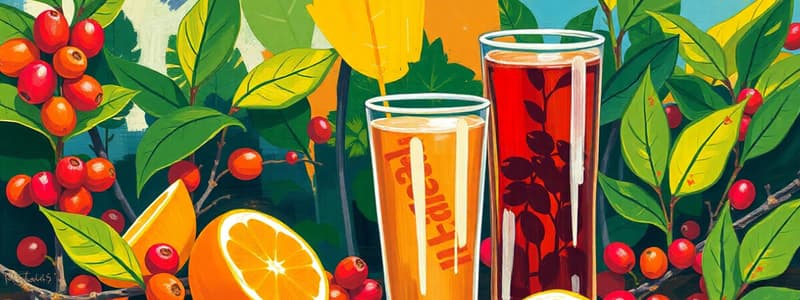Podcast
Questions and Answers
What process is used to remove the pulp from coffee seeds?
What process is used to remove the pulp from coffee seeds?
- Fermentation (correct)
- Washing
- Blending
- Roasting
Coffee was first recorded as a beverage in Europe in the 15th century.
Coffee was first recorded as a beverage in Europe in the 15th century.
False (B)
Which company began as a coffee house in 1690?
Which company began as a coffee house in 1690?
Lloyd's of London
Tea thrives in ______ to subtropical climates.
Tea thrives in ______ to subtropical climates.
Which country primarily produces black tea?
Which country primarily produces black tea?
Match the following countries with their primary functions in coffee production:
Match the following countries with their primary functions in coffee production:
Tea's flavor is primarily derived from sugars found in the leaves.
Tea's flavor is primarily derived from sugars found in the leaves.
List two countries that are among the largest producers of tea.
List two countries that are among the largest producers of tea.
What process is primarily responsible for the dark color of black tea?
What process is primarily responsible for the dark color of black tea?
What process is used to reduce the bitterness of cocoa?
What process is used to reduce the bitterness of cocoa?
Green tea has a strong flavor and is often consumed due to its intense aroma.
Green tea has a strong flavor and is often consumed due to its intense aroma.
White chocolate contains cocoa solids.
White chocolate contains cocoa solids.
In which two countries is green tea primarily produced?
In which two countries is green tea primarily produced?
In what year did Dutch inventor van Houten patent methods to process cocoa?
In what year did Dutch inventor van Houten patent methods to process cocoa?
Chocolates that typically contain about 50% cocoa, along with milk and vanilla, are known as __________ chocolate.
Chocolates that typically contain about 50% cocoa, along with milk and vanilla, are known as __________ chocolate.
Which of the following regions is NOT a primary producer of cocoa?
Which of the following regions is NOT a primary producer of cocoa?
Match the following chocolates with their cocoa content:
Match the following chocolates with their cocoa content:
Match the following varieties of cocoa with their corresponding percentages of global production:
Match the following varieties of cocoa with their corresponding percentages of global production:
Each cocoa pod contains about ________ seeds.
Each cocoa pod contains about ________ seeds.
What is the primary purpose of emulsifiers in chocolate production?
What is the primary purpose of emulsifiers in chocolate production?
Which of the following beverages is NOT classified as caffeinated?
Which of the following beverages is NOT classified as caffeinated?
Cocoa has always been popular since its introduction to Europe.
Cocoa has always been popular since its introduction to Europe.
Theobromine is a stimulant found in cocoa that is chemically identical to caffeine.
Theobromine is a stimulant found in cocoa that is chemically identical to caffeine.
Robusta coffee is known for having a superior flavor compared to arabica coffee.
Robusta coffee is known for having a superior flavor compared to arabica coffee.
Which cultures held significant importance for cocoa, particularly in rituals and ceremonies?
Which cultures held significant importance for cocoa, particularly in rituals and ceremonies?
What is the native region of Coffea arabica?
What is the native region of Coffea arabica?
The two coffee species commonly grown are arabica and ______.
The two coffee species commonly grown are arabica and ______.
Match the coffee species with their characteristics:
Match the coffee species with their characteristics:
Which of the following factors influences the final flavor of coffee?
Which of the following factors influences the final flavor of coffee?
Guarana is commonly used as an ingredient in soft drinks.
Guarana is commonly used as an ingredient in soft drinks.
Name one of the largest coffee producers in the world.
Name one of the largest coffee producers in the world.
Flashcards
Caffeine
Caffeine
A stimulant alkaloid found in several common beverages, like coffee, tea, and cocoa.
Theobromine
Theobromine
A stimulant alkaloid similar to caffeine found in cocoa.
Steeping
Steeping
A process where hot water extracts flavor and compounds from plant material, like in tea or coffee.
Arabica Coffee
Arabica Coffee
Signup and view all the flashcards
Robusta Coffee
Robusta Coffee
Signup and view all the flashcards
Brazil
Brazil
Signup and view all the flashcards
Roasting
Roasting
Signup and view all the flashcards
Blending
Blending
Signup and view all the flashcards
Cocoa Bean Processing
Cocoa Bean Processing
Signup and view all the flashcards
Cocoa Liquor Production
Cocoa Liquor Production
Signup and view all the flashcards
Dutching
Dutching
Signup and view all the flashcards
Chocolate Recipe
Chocolate Recipe
Signup and view all the flashcards
Dark Chocolate
Dark Chocolate
Signup and view all the flashcards
Caffeine in Cola Nuts
Caffeine in Cola Nuts
Signup and view all the flashcards
Traditional Uses of Cola Nuts
Traditional Uses of Cola Nuts
Signup and view all the flashcards
Cola Syrup Production
Cola Syrup Production
Signup and view all the flashcards
Coffee Bean Processing - Stage 1: Cleaning
Coffee Bean Processing - Stage 1: Cleaning
Signup and view all the flashcards
Coffee Bean Processing - Stage 2: Pulp Removal
Coffee Bean Processing - Stage 2: Pulp Removal
Signup and view all the flashcards
Coffee Bean Processing - Stage 3: Fermentation
Coffee Bean Processing - Stage 3: Fermentation
Signup and view all the flashcards
Coffee Bean Processing - Stage 4: Washing & Drying
Coffee Bean Processing - Stage 4: Washing & Drying
Signup and view all the flashcards
Coffee Bean Processing - Stage 5: Roasting
Coffee Bean Processing - Stage 5: Roasting
Signup and view all the flashcards
Coffee Bean Processing - Stage 6: Blending
Coffee Bean Processing - Stage 6: Blending
Signup and view all the flashcards
Tea Plant (Camellia sinensis)
Tea Plant (Camellia sinensis)
Signup and view all the flashcards
Black Tea Production
Black Tea Production
Signup and view all the flashcards
Oxidation in black tea
Oxidation in black tea
Signup and view all the flashcards
Green tea processing
Green tea processing
Signup and view all the flashcards
Black tea
Black tea
Signup and view all the flashcards
Green tea
Green tea
Signup and view all the flashcards
Theobromine in cocoa
Theobromine in cocoa
Signup and view all the flashcards
Cocoa beans
Cocoa beans
Signup and view all the flashcards
Cocoa plant environment
Cocoa plant environment
Signup and view all the flashcards
Study Notes
Caffeinated Beverages
- Several beverages contain caffeine or theobromine, stimulants affecting metabolism, heart rate, and stomach acidity.
- Important caffeinated drinks include coffee, tea, cocoa, cola, maté, and guarana.
- Yerba maté, a South American evergreen, is used as a tea-like beverage, using dried leaves steeped in hot water.
- Guarana is a South American ingredient in some energy drinks, less common elsewhere.
Coffee
- Two species, Coffea arabica and C. canephora, are evergreen shrubs from tropical mountainous regions of Africa.
- Optimal growing conditions include humid environments with steady 20°C temperatures.
- Coffee berries are hand-harvested red berries containing two seeds. Yield averages 2.5 kg per plant annually.
- Two major commercially grown species are:
- Arabica: known for flavour, used in higher-quality coffee, native to Ethiopia highlands; widely grown in South and Central America, Southeast Asia, and East Africa.
- Robusta: bitter and less flavorful; native to central Africa; used primarily in instant coffees; primarily grown in Central Africa, Brazil, and Southeast Asia.
- Major coffee producers are Brazil, Vietnam, Colombia, and Indonesia. Others include Central America and Africa.
- Coffee's final flavour depends on species, growing conditions (e.g., soil nutrients and climate), and processing methods.
- Processing steps include removing defects, removing pulp mechanically, fermentation, washing, drying, and roasting the seeds (beans), and blending them for a specific flavor.
- Coffee's origins are in the Arabian Peninsula. European introduction began in 1615, rapidly spreading across Europe.
- Dutch introduced coffee to Java and Surinam, French introduced it to Caribbean islands (Martinique).
Tea
- Tea (Camellia sinensis) is a shrub (1–2m in height) pruned for easier harvesting grown in subtropical and mountainous regions with ample rainfall and steady temperatures around 20°C, and well-drained slightly acidic soil.
- Major producers include China, India, Kenya, and Sri Lanka.
- Tea flavour comes from caffeine, essential oils, and tannins.
- Processing methods produce:
- Black tea: involves hand-picking young leaves, drying, shredding, oxidizing tannins and phenols until a coppery-brown finish. Popular in India, Sri Lanka, and Europe/North America
- Green tea: involves partially shredding leaves, quick drying minimizes oxidation, producing a light flavour and grassy aroma. Popular in China, and Japan.
Cocoa/Chocolate
- Cocoa (Theobroma cacao), a tropical tree, originates from the understory of South American rainforests.
- Thrives in high humidity, stable temperatures and rich soil.
- Three major cocoa types are criollo (20%), forastero (70%), and trinitario (10%). Today, predominantly grown in West Africa (Côte d’Ivoire and Ghana) and proportionally less in Indonesia and South America.
- Cocoa beans are individual seeds encased in a pulp-like fruit.
- Processing involves harvesting, fermentation, drying, roasting, grinding into cocoa liquor, cocoa butter removal, and alkalizing (dutching).
- Types of chocolate include dark chocolate (high cocoa content), milk chocolate, and white chocolate (no cocoa).
- Cacao was significant in Mayan and Aztec cultures; it spread to Europe by the Spanish in 1550, becoming increasingly popular through 1800s.
Cola
- Cola (Cola nitida), a shrub in tropical Africa, is closely related to cocoa.
- Seeds contain caffeine and aromatic oils.
- Cola seeds are commonly chewed as a stimulant and used as a medicinal agent in West Africa.
- Seeds, through extraction with hot water, produce cola syrup, widely used in cola drinks (popular in Nigeria, Ghana, and Côte d'Ivoire).
Studying That Suits You
Use AI to generate personalized quizzes and flashcards to suit your learning preferences.


